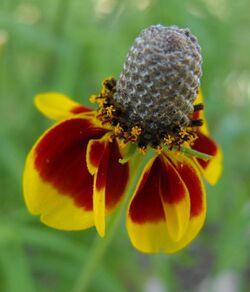Biology:Ratibida columnifera
| Ratibida columnifera | |
|---|---|

| |
| Scientific classification | |
| Kingdom: | Plantae |
| Clade: | Tracheophytes |
| Clade: | Angiosperms |
| Clade: | Eudicots |
| Clade: | Asterids |
| Order: | Asterales |
| Family: | Asteraceae |
| Genus: | Ratibida |
| Species: | R. columnifera
|
| Binomial name | |
| Ratibida columnifera (Nutt.) Wooton & Standl.
| |
| Synonyms[1] | |
|
Ratibida columnaris (Pursh) D.Don | |
Ratibida columnifera, commonly known as upright prairie coneflower,[2] Mexican hat,[3] and longhead prairie coneflower,[4] is a perennial species of flowering plant in the genus Ratibida in the family Asteraceae. It is native to much of North America and inhabits prairies, plains, roadsides, and disturbed areas from southern Canada through most of the United States to northern Mexico.[5]
Description
R. columnifera has medium green, hairy stems that branch occasionally, growing to 30–91 cm (1–3 ft) tall. Leaves are also hairy and are deeply pinnate with 5 to 11 lobes. They are alternate and measure up to 15 cm (6 in) long and 5 cm (2 in) across. The petioles are up to 5 cm (2 in) long.[3]

The inflorescence at the top of the stem consists of 4 to 12 drooping, sterile ray florets that are yellow, brownish red, or brown with yellow borders, surrounding a central column that is up to 5 cm (2 in) long. The column is made up of numerous purplish disk florets, which open in bands starting at the base of the column and moving upwards.[6] Flowers appear June to September.[7]
It is similar to Ratibida tagetes, but the leaves of R. tagetes are closer to the flower, while the leaves of R. columnifera are farther below on the stem.[8]
Distribution and habitat
R. columnifera is native in the United States from Idaho to the west and north, Texas to the south, and Massachusetts to the east. In Canada, it is native in Alberta, British Columbia, Saskatchewan, and Manitoba.[9] The plant is also native in Northern Mexico.[10] Habitats include sunny sites with well-drained soil, such as upland prairies, pastures, roadsides, and open disturbed areas.[6][4]
Uses
The Zuni people use an infusion of the whole plant as an emetic.[11]
Cultivation
Prairie coneflower is valued by gardeners for xeriscaping and native plant gardens for its color and rich fragrance. Grown in garden settings plants are often biennial, growing the first year and dying after blooming in the second year.[12] The prairie coneflower requires dry to medium soil moisture and seldom has serious disease or pest problems. It is hardy in USDA zones 4–9.[13]
References
- ↑ {{citation | mode = cs1 | title = Ratibida columnifera | work = Germplasm Resources Information Network (GRIN) | url = | publisher = [[Organization:Agricultural Research ServAgricultural Research Service (ARS), United States Department of Agriculture (USDA) | access-date = 2010-06-05 }}
- ↑ "Ratibida columnifera". Natural Resources Conservation Service PLANTS Database. USDA. https://plants.usda.gov/core/profile?symbol=RACO3. Retrieved 18 October 2015.
- ↑ 3.0 3.1 "Mexican Hat (Ratibida columnifera)". https://www.illinoiswildflowers.info/prairie/plantx/mexican_hat.htm.
- ↑ 4.0 4.1 "Ratibida columnifera page". https://www.missouriplants.com/Ratibida_columnifera_page.html.
- ↑ Stubbendieck, James L.; Stephan L. Hatch; L. M. Landholt (2003). North American Wildland Plants: A Field Guide (6 ed.). University of Nebraska Press. pp. 280–281. ISBN 978-0-8032-9306-9. https://books.google.com/books?id=K_HRW2zk4xYC.
- ↑ 6.0 6.1 "Know Your Natives – Mexican Hat" (in en). 24 August 2021. https://anps.org/2021/08/24/know-your-natives-mexican-hat/.
- ↑ "Ratibida columnifera - Plant Finder". http://www.missouribotanicalgarden.org/PlantFinder/PlantFinderDetails.aspx?taxonid=277224.
- ↑ Spellenberg, Richard (2001). National Audubon Society Field Guide to North American Wildflowers: Western Region (rev ed.). Knopf. pp. 394. ISBN 978-0-375-40233-3. https://archive.org/details/nationalaudubons00spel/page/393/.
- ↑ "NatureServe Explorer 2.0". https://explorer.natureserve.org/Taxon/ELEMENT_GLOBAL.2.132502/Ratibida_columnifera.
- ↑ "Ratibida columnifera (Nutt.) Wooton & Standl. | Plants of the World Online | Kew Science" (in en). https://powo.science.kew.org/taxon/urn:lsid:ipni.org:names:217868-2.
- ↑ Stevenson, Matilda Coxe 1915 Ethnobotany of the Zuni Indians. SI-BAE Annual Report #30 (p. 59)
- ↑ Barr, Claude A. (1983). Jewels of the plains : wild flowers of the Great Plains grasslands and hills. Minneapolis: University of Minnesota Press. p. 155. ISBN 0-8166-1127-0.
- ↑ "Ratibida columnifera". Missouri Botanical Garden. https://www.missouribotanicalgarden.org/PlantFinder/PlantFinderDetails.aspx?kempercode=b281.
External links
Wikidata ☰ Q7295703 entry
 |

